英汉翻译教程(英语易)
- 格式:doc
- 大小:94.00 KB
- 文档页数:4

新视野英语教程1unit1-unit6汉译英一.汉译英1.昨晚在晚会上你玩得开心吗(have a great time)Did you have a great time at the party last night2.这个学期他选修了英语、计算机和驾驶三门课程。
(take a course)She has taken courses in English,computer and driving this term.3.朋友帮了他很多忙,他欠他们的情。
(have a debt)He has a debt to his friends who helped him a lot.4.我明白了一个道理:永远不要让你的朋友失望。
(let down)I understand that never let your friends down.5.假如你让他待在你家,你就是在自找麻烦。
(ask for)If you let him stay a t your home,you’re asking for trouble.6.善于学习语言的人能够把他们的错误变成通向成功的一大步。
(turn into)A good language learned learned can turn their mistakes into a big step toward success.7.这次事故(accident)给了他一个教训,从此他再也不会酒后驾车了。
(teach someone a lesson)The accident taught him a lesson from them on he would never drive after drinking.8.我们都应该以李明为榜样,学好英语。
(take a leaf out of someo ne’s book)We should take a leaf out of LiMing’book and study English well.9.出于同情,布莱克太太()给了这位可怜的老人一些钱。
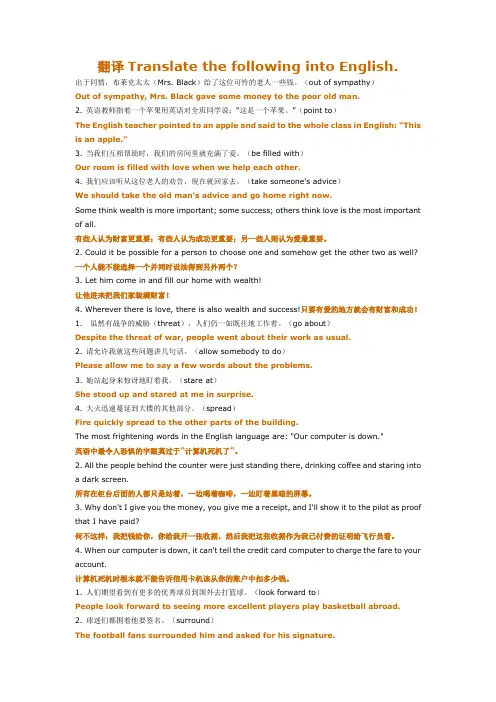
翻译Translate the following into English.出于同情,布莱克太太(Mrs. Black)给了这位可怜的老人一些钱。
(out of sympathy)Out of sympathy, Mrs. Black gave some money to the poor old man.2. 英语教师指着一个苹果用英语对全班同学说:“这是一个苹果。
”(point to)The English teacher pointed to an apple and said to the whole class in English: "This is an apple."3. 当我们互相帮助时,我们的房间里就充满了爱。
(be filled with)Our room is filled with love when we help each other.4. 我们应该听从这位老人的劝告,现在就回家去。
(take someone's advice)We should take the old man's advice and go home right now.Some think wealth is more important; some success; others think love is the most important of all.有些人认为财富更重要;有些人认为成功更重要;另一些人则认为爱最重要。
2. Could it be possible for a person to choose one and somehow get the other two as well?一个人能不能选择一个并同时设法得到另外两个?3. Let him come in and fill our home with wealth!让他进来把我们家装满财富!4. Wherever there is love, there is also wealth and success!只要有爱的地方就会有财富和成功!1.虽然有战争的威胁(threat),人们仍一如既往地工作着。
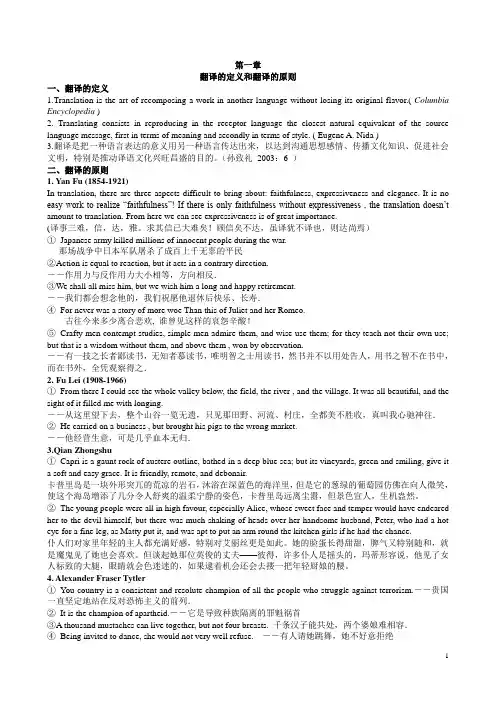
第一章翻译的定义和翻译的原则一、翻译的定义1.Translation is the art of recomposing a work in another language without losing its original flavor.( Columbia Encyclopedia )2. Translating consists in reproducing in the receptor language the closest natural equivalent of the source language message, first in terms of meaning and secondly in terms of style. ( Eugene A. Nida )3.翻译是把一种语言表达的意义用另一种语言传达出来,以达到沟通思想感情、传播文化知识、促进社会文明,特别是推动译语文化兴旺昌盛的目的。
(孙致礼2003:6 )二、翻译的原则1. Yan Fu (1854-1921)In translation, there are three aspects difficult to bring about: faithfulness, expressiveness and elegance. It is no easy work to realize ―faithfulness‖! If there is only faithfulness without expressiveness , the translation doesn’t amount to translation. From here we can see expressiveness is of great importance.(译事三难,信,达,雅。
求其信已大难矣!顾信矣不达,虽译犹不译也,则达尚焉)①Japanese army killed millions of innocent people during the war.----那场战争中日本军队屠杀了成百上千无辜的平民②Action is equal to reaction, but it acts in a contrary direction.――作用力与反作用力大小相等,方向相反.③We shall all miss him, but we wish him a long and happy retirement.――我们都会想念他的,我们祝愿他退休后快乐、长寿.④For never was a story of more woe Than this of Juliet and her Romeo.古往今来多少离合悲欢, 谁曾见这样的哀怨辛酸!⑤Crafty men contempt studies, simple men admire them, and wise use them; for they teach not their own use; but that is a wisdom without them, and above them , won by observation.――有一技之长者鄙读书,无知者慕读书,唯明智之士用读书,然书并不以用处告人,用书之智不在书中,而在书外,全凭观察得之.2. Fu Lei (1908-1966)①From there I could see the whole valley below, the field, the river , and the village. It was all beautiful, and the sight of it filled me with longing.――从这里望下去,整个山谷一览无遗,只见那田野、河流、村庄,全都美不胜收,真叫我心驰神往.②He carried on a business , but brought his pigs to the wrong market.――他经营生意,可是几乎血本无归.3.Qian Zhongshu①Capri is a gaunt rock of austere outline, bathed in a deep blue sea; but its vineyards, green and smiling, give ita soft and easy grace. It is friendly, remote, and debonair.卡普里岛是一块外形突兀的荒凉的岩石,沐浴在深蓝色的海洋里,但是它的葱绿的葡萄园仿佛在向人微笑,使这个海岛增添了几分令人舒爽的温柔宁静的姿色,卡普里岛远离尘嚣,但景色宣人,生机盎然。
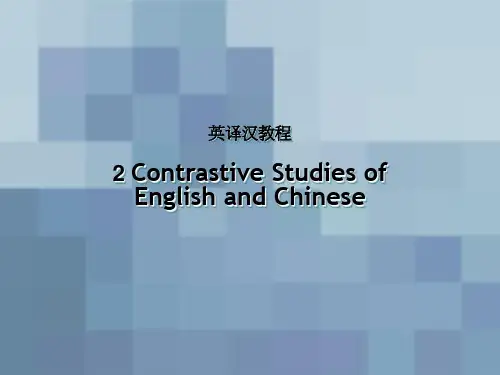

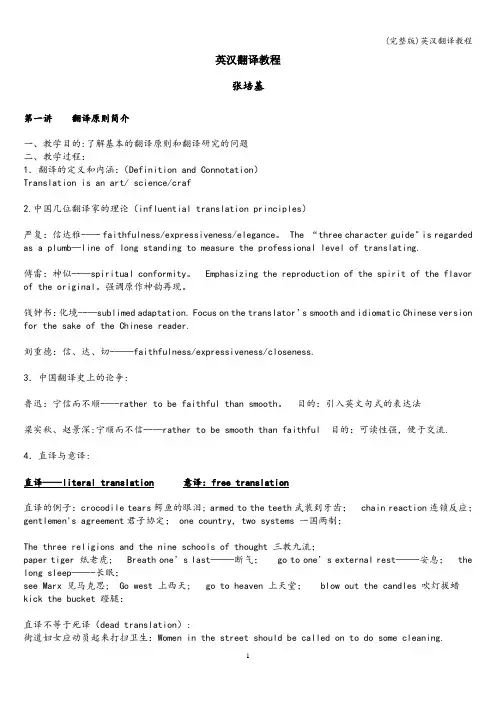
英汉翻译教程张培基第一讲翻译原则简介一、教学目的:了解基本的翻译原则和翻译研究的问题二、教学过程:1.翻译的定义和内涵:(Definition and Connotation)Translation is an art/ science/craf2.中国几位翻译家的理论(influential translation principles)严复:信达雅-—- faithfulness/expressiveness/elegance。
The “three character guide" is regarded as a plumb—line of long standing to measure the professional level of translating.傅雷:神似--—spiritual conformity。
Emphasizing the reproduction of the spirit of the flavor of the original。
强调原作神韵再现。
钱钟书:化境--—sublimed adaptation. Focus on the translator’s smooth and idiomatic Chinese version for the sake of the Chinese reader.刘重德:信、达、切-——faithfulness/expressiveness/closeness.3.中国翻译史上的论争:鲁迅:宁信而不顺-—-rather to be faithful than smooth。
目的:引入英文句式的表达法梁实秋、赵景深:宁顺而不信--—rather to be smooth than faithful 目的:可读性强,便于交流.4.直译与意译:直译—--literal translation意译:free translation直译的例子:crocodile tears鳄鱼的眼泪; armed to the teeth武装到牙齿; chain reaction连锁反应;gentlemen's agreement君子协定; one country, two systems 一国两制;The three religions and the nine schools of thought 三教九流;paper tiger 纸老虎; Breath one’s last——-断气; go to one’s external rest——-安息; the long sleep——-长眠;see Marx 见马克思; Go west 上西天; go to heaven 上天堂; blow out the candles 吹灯拔蜡kick the bucket 蹬腿:直译不等于死译(dead translation):街道妇女应动员起来打扫卫生:Women in the street should be called on to do some cleaning.“In the street" should be replaced by “in the community”.她一大早起床,进城,见到了她的公爹:She got up early, went to the town and saw her public father。
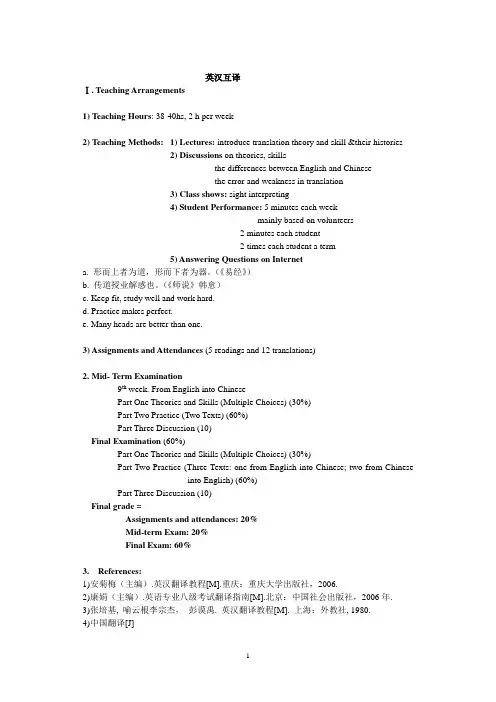
英汉互译Ⅰ. Teaching Arrangements1) Teaching Hours: 38-40hs, 2 h per week2) Teaching Methods: 1) Lectures: introduce translation theory and skill &their histories2) Discussions on theories, skillsthe differences between English and Chinesethe error and weakness in translation3) Class shows: sight interpreting4) Student Performance: 5 minutes each weekmainly based on volunteers2 minutes each student2 times each student a term5) Answering Questions on Interneta. 形而上者为道,形而下者为器。
(《易经》)b. 传道授业解惑也。
(《师说》韩愈)c. Keep fit, study well and work hard.d. Practice makes perfect.e. Many heads are better than one.3) Assignments and Attendances (5 readings and 12 translations)2. Mid- Term Examination9th week. From English into ChinesePart One Theories and Skills (Multiple Choices) (30%)Part Two Practice (Two Texts) (60%)Part Three Discussion (10)Final Examination (60%)Part One Theories and Skills (Multiple Choices) (30%)Part Two Practice (Three Texts: one from English into Chinese; two from Chineseinto English) (60%)Part Three Discussion (10)Final grade =Assignments and attendances: 20%Mid-term Exam: 20%Final Exam: 60%3. References:1)安菊梅(主编).英汉翻译教程[M].重庆:重庆大学出版社,2006.2)康娟(主编).英语专业八级考试翻译指南[M].北京:中国社会出版社,2006年.3)张培基, 喻云根李宗杰,彭谟禹. 英汉翻译教程[M]. 上海:外教社, 1980.4)中国翻译[J]5)陆谷孙(主编). 新编英汉大词典[Z].上海:上海译文出版社,1996.6)谭卫国,蔡金龙(主编).新编英汉互译教程[M].上海:华东理工大学出版社,2005.7)阎佩斯[M].英汉与汉英翻译教学论[M].北京:高等教育出版社,2005.8)英语学习[J]9)英语沙龙[J]10)上海科技翻译[J]任课翻译成果Lecture One1. IntroductionTranslation means the conversion of an expression into another language. To say plainly it is an art to reproduce the exact idea of the author by means of a language different from the original. From the above definition of translation we know that the original thought of the expression must be kept as exactly as possible. Nothing should be added to or translator taken away from the original work. The duty of the translator is simply to change the vocabulary not the thought. In translation therefore, there are two essential elements: accuracy andexpressiveness.Accuracy is the first requisite of translation. The translator must stick to the author’s idea. Words selected and construction sentences constructed must be of such nature as will convey the exact original thought. Expressiveness is to make the translation readily understood. In other words, the translator must express his author’s idea as clearly and as forcibly as he can by the medium he employs. Accuracy is to make the thought definite and exact; while expressiveness is to make the translation, vivid and attractive.2. Theories1)翻译简史简史中国的翻译历史简单分为四个主要阶段。
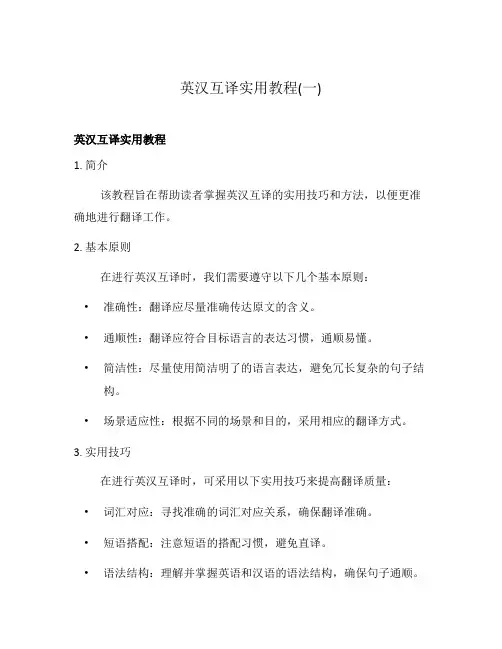
英汉互译实用教程(一)英汉互译实用教程1. 简介该教程旨在帮助读者掌握英汉互译的实用技巧和方法,以便更准确地进行翻译工作。
2. 基本原则在进行英汉互译时,我们需要遵守以下几个基本原则:•准确性:翻译应尽量准确传达原文的含义。
•通顺性:翻译应符合目标语言的表达习惯,通顺易懂。
•简洁性:尽量使用简洁明了的语言表达,避免冗长复杂的句子结构。
•场景适应性:根据不同的场景和目的,采用相应的翻译方式。
3. 实用技巧在进行英汉互译时,可采用以下实用技巧来提高翻译质量:•词汇对应:寻找准确的词汇对应关系,确保翻译准确。
•短语搭配:注意短语的搭配习惯,避免直译。
•语法结构:理解并掌握英语和汉语的语法结构,确保句子通顺。
•上下文理解:通过上下文理解原文的意思,以便更好地进行翻译。
•文化差异:考虑文化差异对翻译的影响,尽量做到意译。
4. 实例演练下面是一些实例演练,旨在帮助读者更好地理解和掌握英汉互译的实用技巧:1.英文句子:“The cat is on the table.” - 翻译成中文:“猫在桌子上。
”2.中文句子:“这是我的手机。
” - 翻译成英文:“This is my cell phone.”3.英文短语:“It’s raining cats and dogs.” -翻译成中文:“下大雨了。
”4.中文短语:“明天见。
” - 翻译成英文:“See youtomorrow.”5. 注意事项在进行英汉互译时,需注意以下几个事项:•专有名词:对于专有名词,应保持与原文一致。
•文化差异:根据不同的文化背景,适当进行意译,以便更好地传达信息。
•翻译细节:注意细节的处理,如时态、人称、单复数等。
6. 总结通过本教程的学习,读者可以掌握英汉互译的实用技巧和方法,提高翻译准确性和表达流畅度。
在实践中不断积累经验,不断提升翻译能力,才能成为一名出色的创作者。
希望本教程能帮助到您,在英汉互译的道路上取得更好的成绩!7. 深度学习在提高英汉互译能力的过程中,深度学习是一个重要的方向。

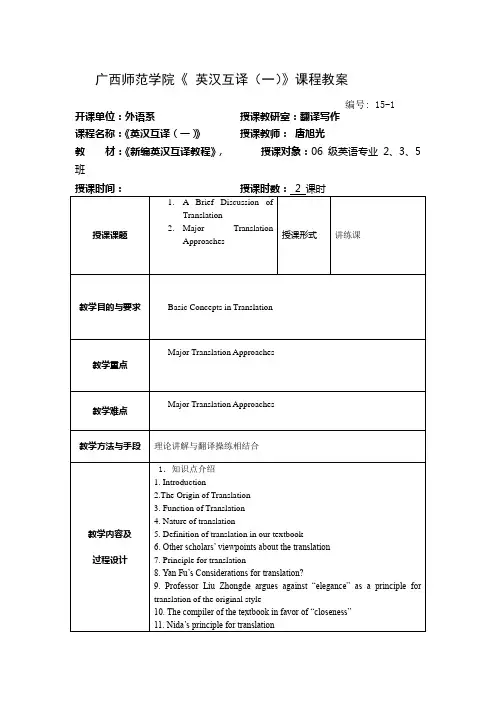
广西师范学院《英汉互译(一)》课程教案编号: 15-1 开课单位:外语系授课教研室:翻译写作课程名称:《英汉互译(一)》授课教师:唐旭光教材:《新编英汉互译教程》,授课对象:06级英语专业2、3、5班《英汉互译(一)》第一讲翻译简论与主要翻译方法(A Brief Discussion of Translation and Major Translation Approaches)1. IntroductionTranslation studies started along with translation practice. Translation theories developed flourishingly in the 20th century, especially in the second half of the last century.In fact, translation, which is a very complex phenomenon, is related to different disciplines, such as linguistics, psychology, sociology, cultural anthropology, communication theory, literary criticism, aesthetics, and semiotics. As translation study is a cross-discipline and cross-culture subject involving many aspects of human knowledge, the lack of a fully acceptable theory of translation should not come as a surprise. Meanwhile, quite a number of translation approaches and strategies have become universally acceptable and widely applicable. They are, of course, the fruits of many translation theorists and translation practitioners at home and abroad.2.The Origin of TranslationLanguage makes it possible for people to communicate with one another freely so as to complete important tasks in human life. Translation makes it possible for people from different languages to communicate with one another so as to complete important tasks in their life.Theodore Savory points out, “Translation is almost as old as original authorship and has a history as honorable and as complex as that of any other branch of literature”(申雨平, 2002:4).In Zhou Dynasty there were different forms of address for translators in different places. “Translators are called Ji in the east, Xiang in the south, Didi in the west, andYi in the north(东方曰寄,南方曰象,西方曰狄鞮,北方曰译)”(陈福康, 2000:3).3. Function of TranslationIt has helped people to better communicate with one another, and in the mean time it has facilitated the development of culture and civilization of all nations, such as the Sutra translation (佛经翻译)in China and the Bible translation in Western countries.Actually, translation, as a means to bridge different cultures, has been playing a very important role in promoting global economic and cultural development, and China in particular benefits a great deal from translation, which is obvious to all.4. Nature of translationOne school of theorists maintain that any interpretation is translation. Translation thus defined includes intra-lingual rewording(语言内的重新措辞), inter-lingual (语言之间的翻译或语际翻译)translation and inter-semiotic transmutation(符号转换).But most scholars who are interested in translation maintain that translation is a communicative activity which entails a most adequate or identical reproduction in a target language of a written message or text in a source language.5. Definition of translation in our textbook as follows: Translation or translating is a communicative activity or dynamic process in which the translator makes great effort to thoroughly comprehend a written message or text in the source language and works very hard to achieve an adequate or an almost identical reproduction in the target language version of the written source language message or text. In terms of its nature or character, translation is both an art and a science as well, since it calls for a good command of at least two languages, a flexible application of their rules, and some knowledge of at least two cultures, as well as a good grasp of the necessary translation theories.6. Other scholars’ viewpoints about the translation1). The traditional viewpoint about the nature of translation is that translation is an art only. This viewpoint is still maintained by Xu Yuanchong(许渊冲), a well-known professor at Beijing University, and a few other scholars.2). Professor Liu Zhongde vigorously advocates that translation is a science as well as an art mainly because of the following reasons:Firstly, like any other art and science, translation requires a good grasp and a flexible use of the necessary specialized knowledge and skills.Secondly, like any other art and science, translation calls for independent, honest and creative effort.Thirdly, just like any other art and science, translation demands that the translator be very careful about and highly responsible for his or her work.7. Principle for translationThe 13 statements on page 81). A translation must reproduce the words of the SLT(Source Language Text).2). A translation must reproduce the ideas (meaning) of the SLT.3). A translation should read like an original work.4). A translation should read like a translation.5). A translation should reflect the style of the original.6). A translation should possess the style of the translator.7). A translation should retain the historical stylistic dimension of the SLT.8). A translation should read as a contemporary piece of literature.9). A translation may add to or omit from the original.10). A translation may never add to or omit from the original.11). A translation should let the readers of the SLT and the target language text (TLT) have essentially the same response.12). A translation should convey what the SLT author intends to convey.13). A translation should satisfy the need of the client.Evidently, though each of the above statements is right in a certain sense, yet it is not adequate or comprehensive enough to serve as a translation principle. Some of the principles proposed by various translation theorists can find their expression in the statements given above. Interlinear translation is an illustration of the first statement. Yan Fu’s three-character principle can be a combination of statements 2, 3 and 6. Nida’s functional equivalence is best express ed in statement 11.8. Yan Fu’s Considerations for translation?Strictly speaking, a translation theory in its true sense in China originated from Yan Fu(严复). He proposed the famous triple principle for translation, namely, faithfulness(信), expressiveness(达) and elegance(雅).1). His faithfulness means that the translated text should be faithful to the original text, ie, the version should keep the content or ideas of the original.2). His expressiveness means that the translated text should be expressive and coherent without anything awkward. In other words, his expressiveness requires that the version should be fluid, smooth, and easy to read and understand.3). His elegance demands that the translated text should be exquisite and that its style ought to be very graceful.9. Professor Liu Zhongde argues against “elegance” as a principle for translation of the original styleHe argued eloquently against “elegance” as a principle for translation of the original style. We all know that not all works are characterized by the elegant style. Different writers display different styles. For instance, Lenin wrote in a bold style, and Hemingway wrote in a simple, symbolic style. Even the same writer shows different styles on different occasions for different purposes. Naturally, different works demonstrate different styles. Thus, it is impossible & absolutely wrong to achieve the effect of elegance in the translated text if the style of the original is not elegant.10. The compiler of the textbook in favor of “closeness”1). We are in favor of Professor Liu’s triple translation principle. He changed Yan Fu’s “elegance” into “closeness”, which represents his contribution to the translation theory. His “closeness” is central in meaning. It is suitable for translation of all types of texts with different styles.2). If the original text is characterized by the elegant style, the translator should do his utmost to render it into a graceful text in the target language whose style is close to the original elegant style.If the original style is highly technical with a wealth of technical terms, thetranslator ought to employ plenty of corresponding technical terms in the target language and make the translated style as close to the original technical style as possible.3). If the original style is colloquial with a lot of informal words and colloquial sentences, the translator should translate it into a text with an informal style as close as possible to the original one by using many colloquial words and informal sentences.If the original style is ornate, the translator should follow suit and make effort to render the translated style as close to the original as possible.If the original text contains some vulgar words and sentences, the translator is not entitled to replace them with elegant words or sentences, and he should reproduce the original by using some corresponding vulgar words and sentences in the receptor language. Translators are duty-bound to do so, for the simple reason that they are translators.4). As we know, Yan Fu’s triple translation principle is highly concise and well rhymed and quite easy to learn by heart, which is one of the reasons why it is still very popular in China today.Professor Liu’s triple principle is similar to Yan Fu’s in that it is equally concise and easy to remember.Though Professor Liu’s triple principle is n ot rhymed, yet it is very forceful and impressive, for the Chinese character “切” is uttered in the falling tone, carrying the implication that faithfully conveying the original style or rendering the translated style as close to the original as possible is absolutely necessary and worth the translator’s great effort.11. Nida’s principle for translationEugene A. Nida and Taber stated emphatically (1969:12): “Translation consists in reproducing in the receptor language the closest natural equivalence of the source language message, first in terms of meaning and secondly in terms of style”.His dynamic equivalence is defined as a translation principle, according to which the translator seeks to translate the meaning of the original in such a way that the target language text wording will produce the same impact on the target text audience as the original wording does upon the source text audience. Later on, Nida changed “dynamic equivalence” into “functional equivalence”, because it seemed much more satisfactory to use the expression “functional equivalence” in describing the degree of adequacy of a translation.12. The literal translation approachProfessor Liu Zhongde (1994: 172) defines literal translation as follows: “In the process of translation, literal translation treats sentences as basic units and at the same time takes the whole passage into consideration; a translator who attaches great importance to literal translation does his or her best to reproduce the ideas and writing style of the original work, retaining in the version as many rhetorical devices and sentence structures of the original as possible.”ExamplesHe is said to be a rough diamond.人们说他是一块浑金璞玉。
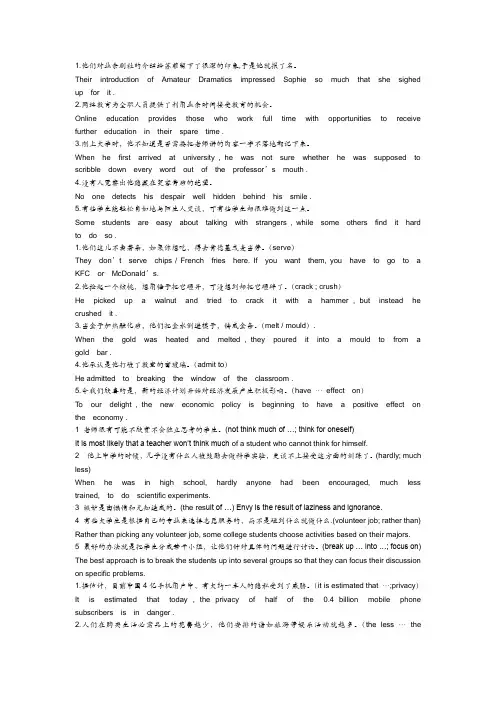
1.他们对业余剧社的介绍给苏菲留下了很深的印象,于是她就报了名。
Their introduction of Amateur Dramatics impressed Sophie so much that she sighed up for it .2.网络教育为全职人员提供了利用业余时间接受教育的机会。
Online education provides those who work full time with opportunities to receive further education in their spare time .3.刚上大学时,他不知道是否需要把老师讲的内容一字不落地都记下来。
When he first arrived at university , he was not sure whether he was supposed to scribble down every word out of the professor’s mouth .4.没有人觉察出他隐藏在笑容背后的绝望。
No one detects his despair well hidden behind his smile .5.有些学生能轻松自如地与陌生人交谈,可有些学生却很难做到这一点。
Some students are easy about talking with strangers , while some others find it hard to do so .1.他们这儿不卖薯条,如果你想吃,得去肯德基或麦当劳。
(serve)They don’t serve chips / French fries here. If you want them, you have to go to a KFC or McDonald’s.2.他捡起一个核桃,想用锤子把它砸开,可没想到却把它砸碎了。
(crack ; crush)He picked up a walnut and tried to crack it with a hammer , but instead he crushed it .3.当金子加热融化后,他们把金水倒进模子,铸成金条。
任文英汉口译教程(一)任文英汉口译教程1. 介绍什么是任文英汉口译•任文英汉口译是一种将英语和汉语进行即场翻译的技能。
•它需要对两种语言的语法、词汇和文化有深入的理解。
为什么学习任文英汉口译•任文英汉口译是一项重要的职业技能,能够为个人带来稳定的收入。
•学习任文英汉口译可以帮助你更好地理解和跨越不同文化之间的沟通障碍。
2. 基本技能英语和汉语的语法和词汇•学习和熟悉英语和汉语的语法规则和词汇是进行口译的基础。
•需要掌握常见的词汇和短语,并且了解它们在不同语境中的意思。
听力技巧•提高听力技巧是进行口译的关键。
•练习听力理解,包括辨别不同口音、语速和语气的能力。
口语表达能力•有效的口语表达是进行口译的重要要素。
•练习口语表达,包括发音、语调和流利度的提高。
3. 提高技巧词汇积累•积累各种领域的词汇是提高口译技能的关键。
•阅读英语和汉语的文本,注意词汇的使用和上下文的语义。
文化背景了解•了解英语和汉语背后的文化背景对于进行口译至关重要。
•学习相关的历史、地理、宗教和社会习俗等方面的知识。
实践口译•参与口译活动和实践是提高口译技能的有效途径。
•可以参加会议、座谈会、翻译实习等活动,提高口译的实际运用能力。
4. 常见问题解答口语速度的问题•如何在快速的对话中保持准确的口译?•练习听取快速口语的相关素材,并进行反复练习。
语法和词汇的问题•如何在语法和词汇方面提高口译的准确性?•阅读大量的英语和汉语文本,注意语法和词汇的正确应用。
文化差异的问题•如何应对不同文化之间的语言障碍?•学习不同文化的习俗、礼仪和价值观,以更好地理解和沟通。
以上是一份简要的任文英汉口译教程,希望对你提供帮助和指导。
请按照教程中的指导逐步提高口译的技能,并不断进行实践和练习。
祝你成功!。
普通高等教育“十一五”国家级规划教材英译汉教程练习参考答案连淑能厦门大学教授、博导Chapter 1 General PrinciplesDrills 1.3.1(1) 1. 这对克服困难很有帮助。
(go a long way towards something/doing something = helpgreatly in [achieving] something, OALD 2002: 525;《新英汉词典》2000: 1577)2. 趁你还年轻的时候,加油吧!/青春不再,趁早努力。
(go it = act in a manner that is quicker,more lively, impatient, etc., than is usual. Longman Dictionary of English Idioms1979: 130;《英汉大词典》1993: 740)3. 我需要更多空闲的时间。
(could do with something = need or want something, LDCE1998: 435)4. 这次失败促使他成功。
([the making of] = a means of gaining great improvement orsuccess, LDCE 1998: 918)5. 我盼望在最后一刻可以挽救和平。
(the eleventh hour = the very last moment, LDCE 1998:478)6.她对此事很了解。
(know a thing or two [about somebody/something] = know a lot [aboutsomebody/something], OALD 2002: 825)7. 她真是爱说话。
/她太喜欢说话了。
(ready = willing to do, LDCE 1998: 1249, 参见“学生用书”243页)8.无线电传来了该地区发现大油田的消息。
If it worked once, it can work twice⑽一次得手,再次不愁例2:The child has started going on all fours.孩子会爬了1.He has a weakness for smokingB.他有抽烟的癖好。
2.A cat is a cleanly animalB.猫是喜爱清洁的动物。
He is dead,as I liveB.他的确死了。
4.His English leaves nothing to be desiredB.他的英语无可挑剔。
5.I would rather have his room than his companyB.我宁愿他不在。
6.Your loss is nothing to mineA.你的损失与我无关7.The patient is waiting to cross the StyxB.这个病人已经等死了。
8.The headmaster made an example of the boy.B.校长惩罚这个孩子,目的在于警告他人。
9.The Disney management is stressing this tradition in an apparent response to suggestions that is culturally insensitive.B. 迪斯尼管理强调,这一传统显然是有人对迪斯尼管理在文化传统方面麻木不仁的态度所提出的种种建议。
10.The effort to shield assets to be passed on to children and grandchildren is making prenups more common among retired people in their 60s and 70s who are remarrying after a spouse has died.B. 努力保护自己的婚前契约,把财产能传到儿孙手中,这在已退休并丧偶、又准备再婚的六七十岁的老人当中十分普遍。
《英汉翻译教程》翻译理论·固定短语·单元小结一卷通Unit 1 Stories
译学点滴:翻译的标准
译学点滴:怎样读懂原文
Unit 2 History
译学点滴:把握全篇而后译
译学点滴:“Readability”
Unit 3 Geography
译学点滴:提高文字水平无止境
译学点滴:用知识武装自己
Unit 4 Economy
翻译理论简介:佛经翻译鸠摩罗什1对佛经贡献
2 翻译倾向
玄奘1对佛经贡献
2主张
翻译理论简介:严复与“信、达、雅”严复1翻译标准
2 《天演论》及其他译作
翻译理论简介:林纾1《巴黎茶花女遗事》及其他译作
2在中国文学发展史上的作用
3钱中书对林译的评论
Unit 5 Culture
翻译理论简介:鲁迅与1译作概述
2对翻译工作的态度
3主张宁信而不顺,凡是翻译,必须兼顾2面
一当二当瞿秋白与鲁迅关于翻译的通信
翻译理论简介:郭沫若与1关于理想翻译的论述
2 主张“翻译工作者必须有”
茅盾1主张“直译,同时保留”
2 1954年关于文学翻译的论述
Unit 6 Literature (1)
翻译理论简介:傅雷1对于翻译工作的态度
2主张“重神思不重形似”
翻译理论简介:关于风格1 周洵良关于风格的论述
2 周洵良对“雅”的解释“”翻译理论简介:王佐良1关于直译与意译的论述
Unit 7 Literature (2)
翻译理论选读:(1) Cicero西塞罗《论演说术》
(2) Saint Jerome 哲罗姆《论最优秀的翻译》
翻译理念选读:Tytler’s Three Principles泰特勒《论翻译的原则》我国对泰特勒三原则的介绍和评论
Unit 8 Popular Science
翻译理论选读:不应该这样翻译马克思的著作恩格斯
翻译理论选读:确切翻译的原则费道罗夫《语言和翻译》
Unit 9 Law
翻译理论选读:A New Concept of Translating Exercise 奈达
翻译理论选读:Paraphrase – The True Road for the Translator斯坦纳
Unit 10 Speeches。